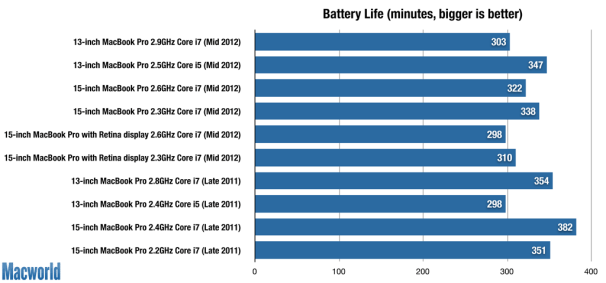Targeting Markets
To grasp the regular MacBook Pro’s still-significant appeal is to consider the specific needs of Apple’s mid-market target audience of non-visually oriented professionals. This class of users, though not creative in the strict definition of “creative pro,” still requires substantial computing power, though not necessarily a super high-resolution display—or the price tag that goes with it.
Apple had developed three laptop models for three distinct sets of buyers: The MacBook was a consumer model for general users; the MacBook Pro catered to a higher-end crowd of creative professionals; and the MacBook Air was there for a smaller group for whom portability outpaced all other traditional notebook appurtenances like an optical drive, spinning hard disk, and multiple connection choices. This crowd appreciated the MacBook Air's friendly specs for traveling light (even if it was just from the bus stop to the office or class).
With the introduction of the Retina MacBook Pro, Apple has re-created its consumer laptop category—or rather restored the one that it had removed with the demise of the mid-market MacBook in 2011. Now, it’s the Retina display model that caters to the creative crowd, the MacBook Pro that covers the consumer mid-market that places a premium on traditional laptop features, and the Air, which caters to a swiftly expanding group that values a combination of portability and increasingly speedy performance.
While this review covers only the non-Retina lineup of 13- and 15-inch MacBook Pros, it's inevitable that some of that Retina sheen has rubbed off on the regular models. The new MacBook Pros offer the same unibody construction, backlit LED screen, lighted keyboard, multi-touch glass trackpad, and FaceTime HD Web cam as the previous models, but push ahead with updated internal architecture for improved performance.
Unlike the new Retina models—where everything is fixed into place, and where you must make decisions on what you'll need down the road at point of purchase—the regular MacBook Pros of both sizes can be customized with do-it-yourself parts, just like their predecessors. With both the 13- and the 15-inch versions, you can easily replace the hard drive and RAM at any point.
Your choice between the 13-inch and the 15-inch models depends on the strength of your arms and back, your need for screen real estate, your taste for higher resolution visuals, and your budget. Pricing from the previous models has stayed the same: The new 13-inch base models are £999 and £1249, while the new 15-inch base models are £1499 and £1799. In comparison, the new Retina MacBook Pros start at £1799 and £2299.
Size and weight concerns
The first thing that stands out about the 15-inch MacBook Pro is its size and weight. It's less than an inch thick, but its dimensions and heft more than compensate for its svelte frame: It measures 14.35 inches by 9.82 inches, and at 5.6 pounds—at least by today's MacBook Air and iPad standards—it is a humongous beast. Or, to be precise, it’s an absolutely gorgeous, powerful hunk of anodized aluminum that can easily serve as a desktop model, should you choose to attach a Thunderbolt display to it.
The 13-inch model, at a little more than a pound lighter, is still a substantial, solidly packed 12.78 by 8.94-inch aluminum slab of computing goodness. But its compact dimensions and lighter frame will make a huge difference if you plan to tote your laptop around on a regular basis. I was not especially bothered by the weight of the 13-inch model, slipped into my backpack, in the long trek from my office to an event, and then to the train station, followed by a nine-block walk. The same journey with the 15-inch model was a much different story.
Also, when using either model in comparison to, say, the MacBook Air, it helps to be thick-wristed. I had to make adjustments in my typing position to accommodate both the thickness and the squared-off edge of the case. The wedge form factor of the MacBook Airs ease pressure on people's sensitive wrists, and that's nearly as important a comfort issue as weight, screen resolution, noise, and heat.
One reason for the extra weight is the presence of a traditional hard drive. Spinning, platter-based drives have an advantage in capacity and price, but they’re also slower and heavier than the flash-based storage present in the Air and in the Retina MacBook Pro. Apple uses its slowest hard drive speed—5400 rpm—as the default offering in its new models.
Nonetheless, both the 15-inch and 13-inch models felt sturdy and well-balanced as I walked with them open—everyone does that from time to time to avoid putting the computer to sleep when switching rooms or going to a colleague's desk or a meeting.
Screen shots
The 15-inch MacBook Pro offers a native screen resolution of 1440 by 900 pixels, along with nearly a dozen supported resolutions at 16:10, 4:3, and 3:2 aspect ratios. However, only the 15-inch model lets you specially configure the screen to a high-resolution 1680 by 1050 pixels with the choice of either a glossy or anti-glare display, for an extra £70.
For the 13-inch models, the resolution options are lower, beginning with 1280 by 800 pixels. It's disappointing that the screen resolution of the new 13-inch MacBook Pro does not match the 1440 by 900 pixels of the 15-inch model—or, for that matter, of the 13-inch MacBook Air. Both the 13-inch MacBook Pro and the new MacBook Air are powered by Intel's new HD Graphics 4000 integrated chip, while the 15-inch models add to that chip Nvidia GeForce GT 650M discrete graphics with either 512MB or 1GB of video RAM and automatic graphics switching.
Both the 13-and 15-inch models support dual display and video mirroring with full resolution on the laptop screen and up to 2560 by 1600 pixels on the second monitor. While much as been made of the extreme viewing angle of the Retina model—and all the accolades are true—I was nonetheless impressed by the wide viewing angle of regular MacBook Pros as well. Moving to either side of a high-resolution image or a video, I noticed very little color or composition distortion—even in extreme sideways viewing positions.
And for the record, though colors were deeper and richer, and detail in both text and images approached the quality of printed matter on the Retina display, users of traditional MacBook Pros will note that its screens are still extremely colorful, vibrant, and pleasing.
Compared with the 15-inch MacBook Pro, the lower resolution 13-inch model colors did look a little faded. That's disappointing for those who prefer a smaller model, and especially considering that the technology already exists to boost the specs of that 13-inch display.
While some users are bothered by glare and reflections bouncing off of the MacBook Pros' glossy screens, I generally have no problem with them, preferring the vibrant colors and deep blacks. However, for those who seek more muted visuals for work or aesthetic reasons, the MacBook Pro Retina displays, with their pixel-doubling technology, have a lot less reflectivity than their siblings, and as a result, images, movies and text, seem almost page-like in their realism.
Performance
Processor type, speed, and cache, as well as memory and disk space all affect performance. The 15-inch models come standard with either a 2.3GHz or 2.6GHz quad-core Intel Core i7 (Ivy Bridge) processor with Turbo Boost of up to 3.3GHz and 3.6GHz respectively. Both 15-inch models have 6MB of L3 cache and come with 4GB and 8GB of 1600MHz memory, respectively, though the 2.3GHz model can be outfitted with 8GB of memory for an extra £100. The 2.6GHz model is configurable to 2.7GHz (with Turbo Boost up to 3.7GHz) with 8MB of L3 cache for an extra £240.
Intel's Turbo Boost technology lets the processor run higher than its base frequency because it dynamically controls the CPU's clock speed. Turbo Boost kicks into action automatically when Mac OS X requests the highest performance from the processor.
The 15-inch MacBook Pros come standard with either a 500GB or a 750GB 5400-rpm hard drive, as did the previous generation. But that too can be upgraded to either a larger capacity or a faster drive for up to £80. Solid-state drives (SSDs) are available in 128GB, 256GB, and 512GB capacities for up to £720, depending on which machine you're upgrading.
Compared with their immediate predecessors released late last year, the MacBook Pro non-Retina line shows a modest uptick in performance. According to Macworld's lab tests, the low-end 15-inch 2.3GHz Core i7 model with 4GB of RAM came in with a Speedmark score of 221, 14 percent faster than the previous low-end 15-inch model, with its 2.2GHz Core i7 (Sandy Bridge) processor and 4GB of memory. That previous model scored 190 on the benchmark test.
Gains for the new 15-inch high-end 2.6GHz Core i7 model with 8GB of memory were more restrained. That unit's Speedmark score hit 239, only 8 percent faster than the previous analogous model, with its 2.4GHz Core i7 (Sandy Bridge) processor and 4GB of memory. That previous model scored 219 in the benchmark test.
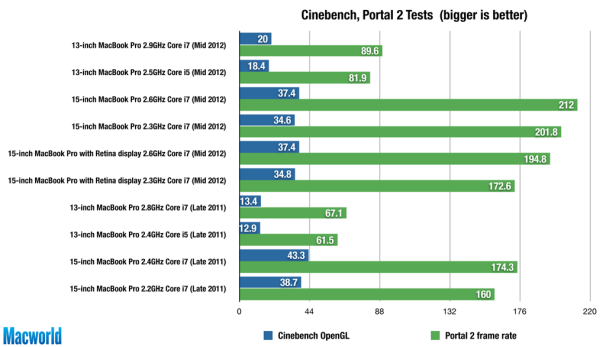
How We Tested: In Cinebench, we ran that application’s OpenGL frames-per-second test. Using Steam and Steam for Mac, we created a self-running demo for Portal and recorded the frames-per-second rating.
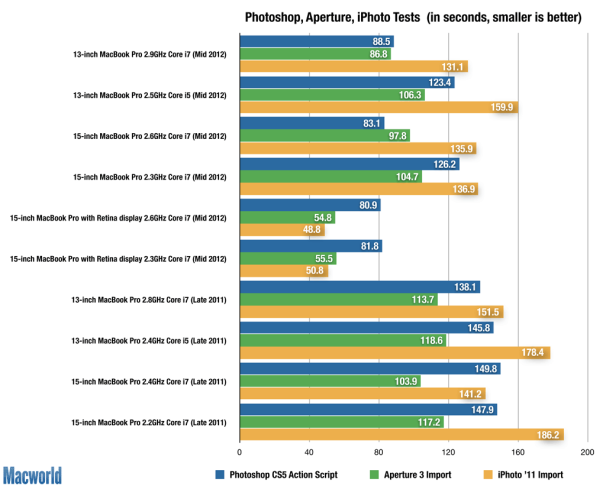
How We Tested: In Photoshop CS5, we ran an action script on a 100MB image file. In Aperture 3 we performed an Import and Process on 207 photos. In iPhoto ’11, we imported 500 photos.
Lab testing noted a wider improvement in the new 15-inch models’ frame rates, and somewhat surprisingly, the 2.6GHz model topped all other MacBook Pros in our Portal 2 benchmark—including the mighty Retina model. The high-end regular laptop scored 18 percent faster than its analogous predecessor, while the 3.2GHz model clocked 21 percent faster than the previous analogous model. Both new MacBook Pros smoked the Retina model in the frame rate test, despite the fact that the Retina laptops and the regular 15-inch MacBook Pros have the same graphics hardware. The 2.3GHz MacBook Pro’s GeForce GT 650M has 512MB of memory, versus 1GB in the other three 15-inch laptops.
For the 13-inch models, the low end features a 2.5GHz dual core Intel Core i5 processor with Turbo Boost up to 3.1GHz and 3MB of L3 cache; the high end has a 2.9GHz dual core Intel Core i7 with Turbo Boost up to 3.6GHz and 4MB of L3 cache. Hard drive space in the current models matches the previous generation at 500GB for the low-end model and 750GB for the high-end model.
Our lab tests found that the new low-end 13-inch MacBook Pro, with a Speedmark score of 161, clocked 9 percent faster than the previous analogous low-end model, which scored 146. The new high-end 13-inch MacBook Pro, with a Speedmark score of 189, is 15 percent faster overall than its predecessor, which scored 164 on the benchmark.
The most notable improvement showed up in graphics performance, demonstrating the effect of the upgraded Intel HD Graphics 4000 chip from the previous Intel HD Graphics 3000. The new high- and low-end 13-inch MacBook Pros showed 42 percent and 52 percent more frames per second, respectively, in the Cinebench OpenGL test, over the reference models. Both new 13-inch laptops clocked a 33 percent higher frame rate in Portal 2, and are 10.5 percent faster than the previous models in the Handbrake tests.

How We Tested: We duplicated a 2GB file, created a Zip archive in the Finder from the two 2GB files, and then unzipped it. In Pages ’09 we converted and opened a 500-page Microsoft Word document.
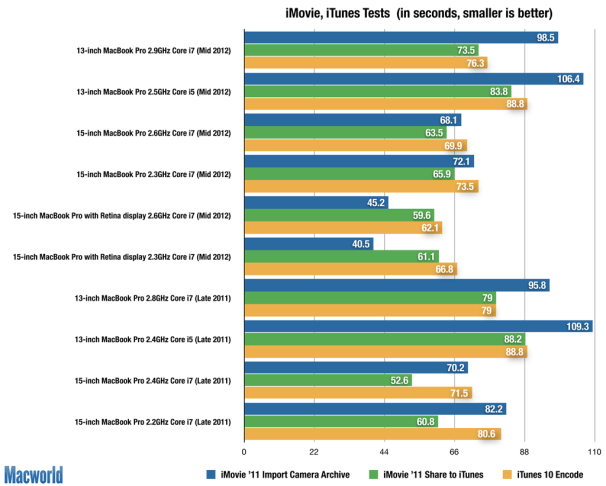
How We Tested: In iMovie ’11, we imported a two-minute clip from a camera archive, and performed a Share Movie to iTunes for Mobile Devices function. In iTunes, we converted 135 minutes of AAC audio files to MP3 using the High Quality setting.
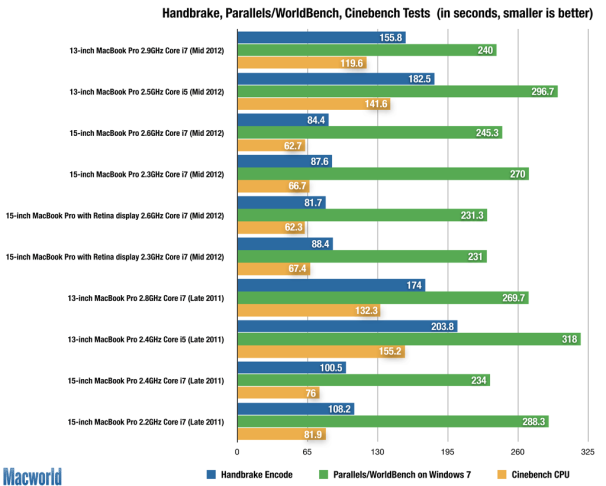
How We Tested: In Handbrake 0.9.5, we encoded a single chapter (to H.264 using the application's Normal settings) from a DVD that was previously ripped to the hard drive. We installed Parallels 6 and ran WorldBench 6’s Multitask test. In Cinebench, we recorded how long it took to render a scene with multiprocessors.
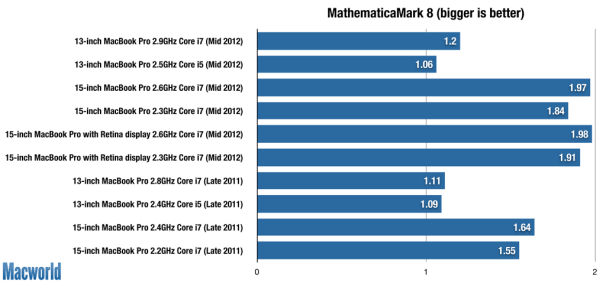
How We Tested: We ran Mathematica 8’s Evaluate Notebook Test.
Compared to each other, the new high-end 13-inch 2.9GHz system clocked 17 percent faster overall than the new low-end 2.5GHz model. Beefed up RAM (8GB as opposed to 4GB in the low-end model) accounted for the improvements in the Photoshop results over the low-end model and previous models. However, the upgraded i7 processor is more powerful than the i5 processor in the low-end version, and the consequences showed up across the testing suite as the i7 bested its i5 sibling in nearly every test.
Connectors, sound, and noise
Both non-Retina laptops have the older MagSafe power connector, as opposed to the Retina model, which has an updated part to accommodate its thinner frame. On the left side of the case, the 15-inch model has ports for gigabit ethernet, FireWire 800, and Thunderbolt, two USB 3 ports, an SDXC card slot, and separate ports for audio in and audio out. The right side is dominated by the 8X SuperDrive for double-layer DVD burning. The only difference for the 13-inch model is the combined audio in/out port, the same as the Retina model.
The 15-inch MacBook Pros sport speakers with a subwoofer underneath a set of grilles on either side of the keyboard, and they're not bad at all; I did not perceive much deficiency in the bass, and the sound is rather loud at maximum volume, with little distortion or feedback. They're not high-end speakers, but they're better than most computer speakers I've heard.
While the 13-inch model can mostly be described as a mini 15-inch model, there are some key differences when it comes to the sound system. The smaller model lacks the topside grilles and thus sound from the speakers is inferior in quality compared to the larger model. Music sounds flatter, tinnier, and has less resonance and depth than the speakers on the 15-inch MacBook Pro. If sound quality is a big part of your user experience, either in creating or listening to audio, be sure to take that into account.
The other side of sound is noise. Apple appears to have mostly solved the noise problem for normal operations with these new models. Even running a video with the DVD in the drive did not kick up the fans or significantly add to the noise level, though I did hear the drive running, faintly, when I put my ear very close to the machine. When I watched a movie from the hard drive, it was similarly quiet, and I never heard the fan with either model.
As for the heat factor, I can say that despite a very small bit of warming, the bottom of the unit stayed cool and comfortable in my lap for a long time during regular use, and even when watching streaming video or video running via DVD in the drive. Both models heated up significantly however with Handbrake encoding. The bottom of the case, especially near where the lid opens and closes, tended to get too warm to keep on my lap during that operation.
Battery life
The 13-inch MacBook Pro has a built-in 63.5-watt-hour lithium-polymer battery, while the 15-inch model has a 77.5-watt battery. Apple says battery life lasts about 7 hours on all the new MacBook Pro models, based on its "wireless web test suite," though Macworld's lab tests are a little more rigorous. We found battery life in the same ballpark throughout the new models, with fairly negligible variations. All the new laptops topped five hours of continuous use, with the 13-inch 2.5GHz model besting all other new models at 5 hours and 47 minutes.
The bottom of the line 15-inch MacBook Pro came in second place in battery life at 5 hours and 38 minutes. The poorest battery performance came from the 13-inch model with the i7 processor. It lasted only 5 hours and 3 minutes.
All the regular MacBook Pro models compared favorably with the Retina models in terms of battery life. The 2.3GHz Retina MacBook Pro lasted 5 hours and 10 minutes, while the top of the line Retina model conked out at just under 5 hours.
Central IT's buying advice
The traditional MacBook Pros hold fast to their unibody form factor and design, upgradability, and price, and target the mid-market of non-creative professionals that seeks to balance features with affordability. The new MacBook Pros are not flashy like the new Retina MacBook Pros, but they offer advantages in price and the flexibility to get into the system and tailor it to your needs after purchase.
With form factors shrinking, the 15-inch MacBook Pros seem increasingly like desktop machines, with the 13-inch models taking precedence on the portable side of the equation. If you’re in the market for a 13-inch model, the obvious choice, especially in terms of performance, is the 2.9GHz Core i7 model. It tops its Core i5 sibling in almost every benchmark. While I wish the screen resolution were higher, the 2.9GHz model is a beautiful machine.
If you bought one of the MacBook Pros last year, there's no compelling reason to purchase one of these new machines. Simply upgrading the RAM or the hard drive might benefit performance enough to nearly meet or exceed the new offerings. However, if you've been hanging on to an older system and are experiencing sluggish performance, you won't be sorry if you picked up one of these new laptops.
That said, if your heart—not to mention your professional needs—settle on a 15-inch model, the flagship MacBook Pros with a Retina Display come at a steep price. For artists, photographers, and videographers taking this on the road, it can't be beat—even at the £300 premium over the non-Retina MacBook Pros. Moreover, if you're planning to add a solid-state drive and more RAM to one of the 15-inch models, the price of upgrading may actually meet or exceed that premium. If you can live without the DVD drive and spinning hard disk, shelling out for a machine with a better screen, and a lighter, thinner case, is essentially a no-brainer.




